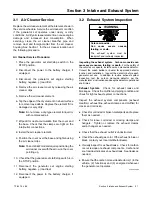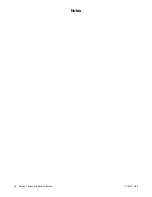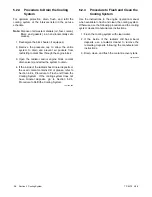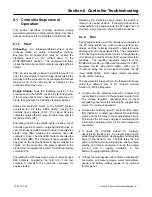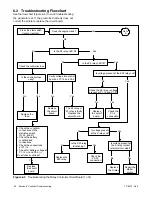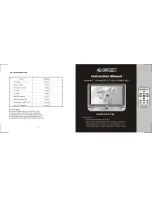
TP-6073 4/06
27
Section 5 Cooling System
Section 5 Cooling System
5.1 General
The water-cooled engine uses a closed-loop cooling
system that includes an engine water pump which
circulates the cooling water and an engine thermostat
that regulates cooling water flow to maintain a constant
engine temperature.
The radiator cools hot water from the engine and returns
it to the water pump for recirculation in the cooling
passages of the engine. For a cooling system with a
remote radiator, the belt guard replaces the radiator and
its mounting provisions on the engine.
Hoses then
connect the water pump and thermostat port to the
remote radiator.
5.2 Cooling System
The cooling system maintenance information applies to
radiator-cooled models. Radiator-cooled models have
a radiator with a pressure cap and coolant recovery
tank.
Hot coolant and steam.
Can cause severe injury or death.
Before removing the pressure cap,
stop the generator set and allow it to
cool. Then loosen the pressure cap
to relieve pressure.
WARNING
Checking the coolant level. Hot coolant can cause severe
injury or death.
Allow the engine to cool. Release pressure
from the cooling system before removing the pressure cap. To
release pressure, cover the pressure cap with a thick cloth and
then slowly turn the cap counterclockwise to the first stop.
Remove the cap after pressure has been completely released
and the engine has cooled. Check the coolant level at the tank
if the generator set has a coolant recovery tank.
Note: Engine damage.
Bleed the air from the cooling
system to prevent overheating and subsequent
engine damage.
Note: Block heater damage.
The block heater will fail
if the energized heater element is not immersed
in coolant. Fill the cooling system before turning
on the block heater. Run the engine until it is
warm, and refill the radiator to purge the air from
the system before energizing the block heater.
x:sm:003:001
5.2.1
Coolant Level Check
Check the coolant level in the coolant recovery tank and
maintain the coolant level between the high and low
marks or approximately 1/4 full in tanks without marks.
Note:
Periodically check the coolant level by removing
the pressure cap. Do not rely solely on the level in
the coolant recovery tank. Add fresh coolant until
the level is just below the overflow tube opening
of the filler neck.
x:sm:003:002
5.2.2
Cooling System Component
Inspection
To prevent generator shutdown or damage caused by
overheating:
D
Keep the cooling air inlets clean and unobstructed.
D
Inspect the radiator’s exterior for obstructions.
Remove dirt and foreign material using a soft brush or
cloth to avoid damaging the radiator fins.
D
Check the hoses and connections for leaks. Replace
any cracked, frayed, or spongy hoses.
D
Check the condition and tension of the radiator fan
and water pump belt(s).
Follow the belt tension
procedure in this manual and/or the engine operation
manual.
D
Check the pressure cap seal and replace a cracked or
deteriorated cap. Remove dirt and other debris from
the pressure cap and filler neck. The pressure cap
raises the boiling point of the coolant, enabling higher
operating temperatures. Replace a leaking pressure
cap with one rated for the same pressure.
The
pressure cap rating usually appears on the pressure
cap.
x:sm:003:003
Summary of Contents for 10EOR
Page 10: ...10 Safety Precautions and Instructions TP 6073 4 06 Notes...
Page 12: ...TP 6073 4 06 12 Service Assistance Notes...
Page 22: ...TP 6073 4 06 22 Section 3 Intake and Exhaust System Notes...
Page 26: ...TP 6073 4 06 26 Section 4 Fuel System Notes...
Page 30: ...TP 6073 4 06 30 Section 5 Cooling System Notes...
Page 38: ...TP 6073 4 06 38 Section 6 Controller Troubleshooting Notes...
Page 54: ...TP 6073 4 06 54 Section 8 Component Troubleshooting Notes...
Page 60: ...TP 6073 4 06 60 Section 9 Generator Disassembly Reassembly Notes...
Page 82: ...TP 6073 4 06 82...
Page 83: ...TP 6073 4 06 83...









